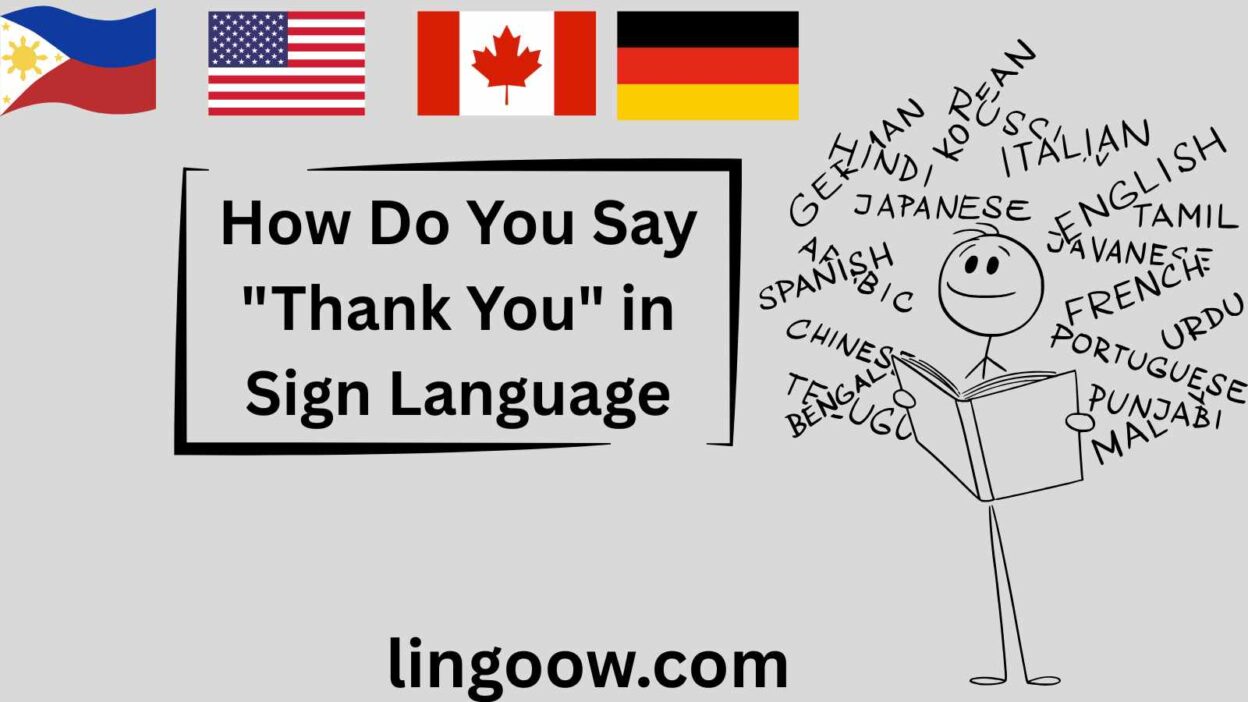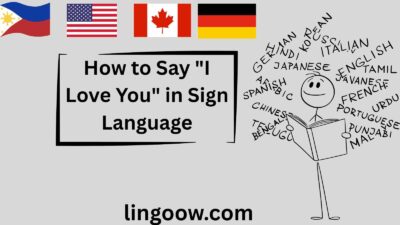Imagine this: You’re at a bustling international airport in Tokyo, jet-lagged and fumbling with your luggage.
A kind stranger, noticing your struggle, rushes over and helps you hoist your bag onto the cart.
As you catch your breath, you blurt out a heartfelt “Thank you!” in English.
The stranger smiles warmly, nods, and responds with a quick, elegant hand gesture—fingers touching the chin, then sweeping forward in a graceful arc.
It’s the Japanese Sign Language (JSL) way of saying arigatou. In that split second, words dissolve, and a universal bridge of gratitude spans the language barrier.
No spoken syllables needed—just a simple, profound sign that says, “I see you, I appreciate you.”
This moment captures the magic of “thank you” in sign language: a silent symphony of hands that transcends borders, echoing the human heart’s innate need to express appreciation. But what if we expand beyond signs to the spoken world? Across every culture, “thank you” binds us in shared humanity, evolving from ancient rituals to modern niceties. In this post, we’ll journey through spoken expressions in over 70 languages from 20+ countries per region, uncovering how gratitude weaves through our diverse tapestry. Get ready for a heartfelt exploration—because saying “thank you” isn’t just polite; it’s a global love language.
Quick Reference Table: “Thank You” Around the World
Here’s a handy table with 15+ languages, their phrases, and cultural nuggets. Use it as your cheat sheet!
| Language | Phrase | Cultural/Linguistic Insight |
|---|---|---|
| English (USA/UK) | Thank you | Rooted in Old English “þanc,” emphasizing humility; overuse in daily life reflects polite restraint. |
| Spanish (Spain/Mexico) | Gracias | From Latin “gratia” (grace); said with eye contact for sincerity in Latin cultures. |
| French (France) | Merci | Short for “merci beaucoup”; paired with a nod, it’s a staple of French elegance. |
| German (Germany) | Danke | Means “thanks”; formal “Danke schön” adds warmth in structured social norms. |
| Italian (Italy) | Grazie | Echoes “grace”; often followed by “prego” (you’re welcome) in hospitable exchanges. |
| Mandarin (China) | Xièxiè (谢谢) | Literal “thank thank”; repeated for emphasis in collectivist harmony. |
| Hindi (India) | Dhanyavaad (धन्यवाद) | From Sanskrit “blessing received”; reflects spiritual gratitude in diverse festivals. |
| Japanese (Japan) | Arigatou (ありがとう) | Means “difficult to exist” (rare kindness); bowing amplifies respect. |
| Korean (South Korea) | Gamsahamnida (감사합니다) | Formal politeness; casual “gomawo” for friends shows hierarchy. |
| Arabic (Egypt/Saudi Arabia) | Shukran (شكراً) | From “shukr” (gratitude to God); common in 22 Arab nations with Islamic roots. |
| Swahili (Kenya/Tanzania) | Asante | Means “thanks”; used across East Africa, symbolizing communal ubuntu. |
| Zulu (South Africa) | Ngiyabonga | “I am grateful”; ties to Nguni traditions of reciprocity. |
| Yoruba (Nigeria) | O dáadáá | Expresses deep thanks; integral to Yoruba hospitality rituals. |
| Māori (New Zealand) | Kia ora / Ngā mihi | “Kia ora” is hello/thanks; reflects whakawhanaungatanga (kinship). |
| Hawaiian (USA/Hawaii) | Mahalo | Means “thanks” but implies conservation; core to aloha spirit. |
| Cherokee (USA) | Wado (ᏩᏙᎯ) | Simple and profound; used in ceremonies honoring ancestors. |
| Samoan (Samoa) | Fa’afetai | From fa’a (way of) + fetai (thanks); emphasizes fa’a Samoa (Samoan way). |
| Russian (Russia) | Spasibo | “God save you”; historical Orthodox influence. |
| Portuguese (Brazil) | Obrigado/a | Gender-specific; vibrant in Brazil’s festive culture. |
| Turkish (Turkey) | Teşekkür ederim | “I thank you”; polite in Ottoman hospitality legacy. |
(Note: This is just a starter—dive into sections below for 70+ more!)
European Languages: Elegance in Every “Merci”
Europe, with its cobblestone streets and café cultures, treats “thank you” like a finely aged wine—refined, contextual, and oh-so-personal. Let’s stroll through five languages from 20+ countries (think France, Spain, Germany, Italy, UK, Russia, Poland, Netherlands, Sweden, Portugal, Greece, Hungary, Czech Republic, Romania, Bulgaria, Ukraine, Belarus, Austria, Switzerland, Belgium).
- French (France, Belgium, Switzerland): “Merci” rolls off the tongue like a kiss. In Paris, it’s whispered over croissants; culturally, it’s tied to Enlightenment politeness, where gratitude oils social gears without excess emotion.
- Spanish (Spain, Mexico—but Europe focus: Spain): “¡Gracias!” bursts with passion. Spaniards use it liberally at tapas bars, reflecting Latin warmth—eye contact seals the deal, honoring personal connections.
- Italian (Italy): “Grazie mille!” (a thousand thanks) is effusive, like a Nonna’s hug. In Rome’s piazzas, it’s laced with Catholic grace, evolving from Latin roots in communal feasts.
- German (Germany, Austria, Switzerland): “Danke schön” adds floral charm to efficiency. Germans view it as punctuality’s partner—formal in Bavaria, casual in Berlin, rooted in Protestant work ethic.
- Others Across Europe: In Russian (“Spasibo”—God save you), it’s a post-Soviet nod to resilience; Polish (“Dziękuję”) warms Warsaw winters; Swedish (“Tack”) is minimalist like IKEA; Greek (“Efcharistó”) echoes Eucharist rituals. Across 20+ nations, Europe’s “thank you” evolved from feudal hierarchies to democratic equals, fostering trust in diverse unions like the EU.
Emotionally, it’s the quiet “danke” after a Berlin kindness that reminds us: gratitude here is understated power.
Asian Languages: Harmony in a Bow or a Smile
Asia’s vast mosaic—from Himalayan peaks to Tokyo neon—infuses “thank you” with profound respect. We’ll cover Mandarin, Hindi, Japanese, Korean, Arabic (spanning 20+ countries: China, India, Japan, South Korea, Saudi Arabia, UAE, Egypt, Indonesia, Pakistan, Bangladesh, Turkey, Iran, Thailand, Vietnam, Philippines, Malaysia, Singapore, Afghanistan, Iraq, Syria).
- Mandarin (China, Singapore): “Xièxiè” (sheh-sheh) is doubled for intensity, mirroring Confucian harmony. In Beijing markets, it’s a nod to collective good.
- Hindi (India, across 28 states): “Dhanyavaad” invokes blessings. Bollywood films amplify it during Diwali, blending spiritual depth with vibrant chaos.
- Japanese (Japan): “Arigatou gozaimasu” (formal) pairs with bows—depth shows in angle. Post-WWII, it rebuilt social bonds.
- Korean (South Korea): “Gamsahamnida” bows to hierarchy; K-dramas make it romantic. In Seoul, it’s survival in fast-paced life.
- Arabic (20+ countries): “Shukran” (Egypt) to “Shukran jazilan” (Saudi). Rooted in Quran’s 100+ gratitude mentions, it’s divine across deserts and cities.
- More: Thai (“Khob khun”) wais palms; Vietnamese (“Cảm ơn”) smiles softly; Indonesian (“Terima kasih”) in 17,000 islands fosters unity. Asia’s expressions? A tapestry of humility, where “thank you” heals historical wounds and honors elders.
Feel the bow’s weight—it’s Asia whispering, “Your kindness echoes eternally.”
African Languages: Ubuntu in Every “Asante”
Africa’s 54 nations pulse with communal gratitude, where “thank you” is ubuntu (I am because we are). Spotlight: Swahili, Zulu, Yoruba (20+ countries: Kenya, South Africa, Nigeria, Tanzania, Egypt, Ethiopia, Ghana, Uganda, Algeria, Morocco, Senegal, Côte d’Ivoire, Cameroon, DR Congo, Zimbabwe, Angola, Tunisia, Libya, Sudan, Mali).
- Swahili (Kenya, Tanzania, Uganda): “Asante sana” (thanks a lot) unites East Africa. In safaris, it’s reciprocity’s rhythm.
- Zulu (South Africa): “Ngiyabonga kakhulu” in vibrant townships; post-apartheid, it rebuilds bridges.
- Yoruba (Nigeria, Benin): “Ẹ ṣeun” in markets; tied to Ifá divination, it’s ancestral thanks.
- Others: Amharic (“Ameseginalehu,” Ethiopia) in coffee ceremonies; Hausa (“Na gode,” Nigeria/Niger) in Sahel trades; Wolof (“Jërëjëf,” Senegal) smiles wide. Across 20+ nations, Africa’s “thank you” evolved from oral epics to anti-colonial anthems, emphasizing community over self.
Heart-swelling truth: In Africa’s drumbeat, gratitude is the glue holding souls together.
Indigenous & Island Languages: Ancestral Whispers of Aloha
From Pacific waves to Native trails, these tongues honor earth and kin. Focus: Māori, Hawaiian, Cherokee, Samoan (20+ countries/regions: New Zealand, USA/Hawaii, USA/Native, Samoa, Australia/Aboriginal, Canada/Inuit, Fiji, Papua New Guinea, Vanuatu, Solomon Islands, Tonga, Tahiti, Guam, Palau, Marshall Islands, Micronesia, Cook Islands, Niue, Tokelau, Rapa Nui/Chile).
- Māori (New Zealand): “Ngā mihi” in haka circles; Treaty of Waitangi roots it in reconciliation.
- Hawaiian (Hawaii, USA): “Mahalo” conserves spirit; surf culture embodies aloha.
- Cherokee (USA): “Wado” in powwows; survives Trail of Tears resilience.
- Samoan (Samoa, American Samoa): “Fa’afetai tele” in fa’alavelave (family events); communal core.
- More: Navajo (“Ahéhee'”), Inuit (“Qujannamiik,” Canada), Fijian (“Vinaka”), Aboriginal (“Yaama”). In 20+ isles/lands, these evolved from oral lore, resisting colonization—gratitude as survival song.
Tears well up: These words carry ancestors’ voices, reminding us we’re all islanders on earth’s blue marble.
Cultural Insights: The Timeless Evolution of Gratitude
“Thank you” isn’t static—it’s a living heirloom. In ancient Egypt (hieroglyphs ~3000 BCE), it was offerings to gods; Rome’s “gratia” birthed Romance languages amid empire falls. Medieval Europe tied it to feudal oaths; Asia’s Confucianism (500 BCE) made it harmony’s key. Africa’s griots sang it in epics; Indigenous rituals wove it into creation stories. Religiously, Bible’s 50+ thanks, Quran’s shukr, Hindu Vedas’ blessings. Historically, WWII letters brimmed with it; today, #ThankYou trends globally. Evolution? From survival pacts to emoji hearts—always rooting civs in empathy.
Proverbs: Wisdom Wrapped in Gratitude
- English: “Thanks are the currency of good manners.”
- Chinese: “A word of thanks brings a second kindness.”
- Swahili: “Asante ni mali” (Thanks is wealth).
- Hawaiian: “Mahalo no (thanks forever).”
- Arabic: “Shukr is the key to rizq (blessings).”
- Zulu: “Inkunzi ayiphumi emgodini” (Gratitude doesn’t exit the pen—keep giving).
- Japanese: “Arigatou wa kekkon shite wa ikenai” (Don’t marry thanks—reciprocate endlessly).
- Hindi: “Shukriya dil se” (Thanks from the heart).
These gems? Emotional mirrors of cultural souls.
FAQs: Your Burning Questions Answered
Why do “thank you” words sound similar in many languages? Indo-European roots (e.g., Latin “gratia” → gracias/merci) plus universal phonetics—soft consonants mimic warmth.
What’s the oldest known usage? Sumerian cuneiform (~3500 BCE): “Dug-ga” (good voice) for gifts.
How do cultures differ in expressing it? West: verbal/formal; East: gestural/hierarchical; Africa: communal songs; Islands: nature-tied.
Is overuse rude? In Japan, yes—save for true depth; in USA, no—it’s casual glue.
Conclusion: The Universal Hug of “Thank You”
From a Tokyo sign to a Zulu chant, “thank you” is our world’s heartbeat—raw, real, relentlessly human. It mends divides, sparks joy, and whispers, “You’re not alone.” In every culture, it’s evolved yet endures, proving gratitude’s power to heal and unite.
Now, your turn! Drop a comment: How do you say “thank you” in your language? Share a story of a kindness that stuck. Tag a friend who needs this reminder. Let’s flood the comments with global thanks—because one “arigatou” can change everything. Mahalo for reading—asante sana! 🌍❤️




